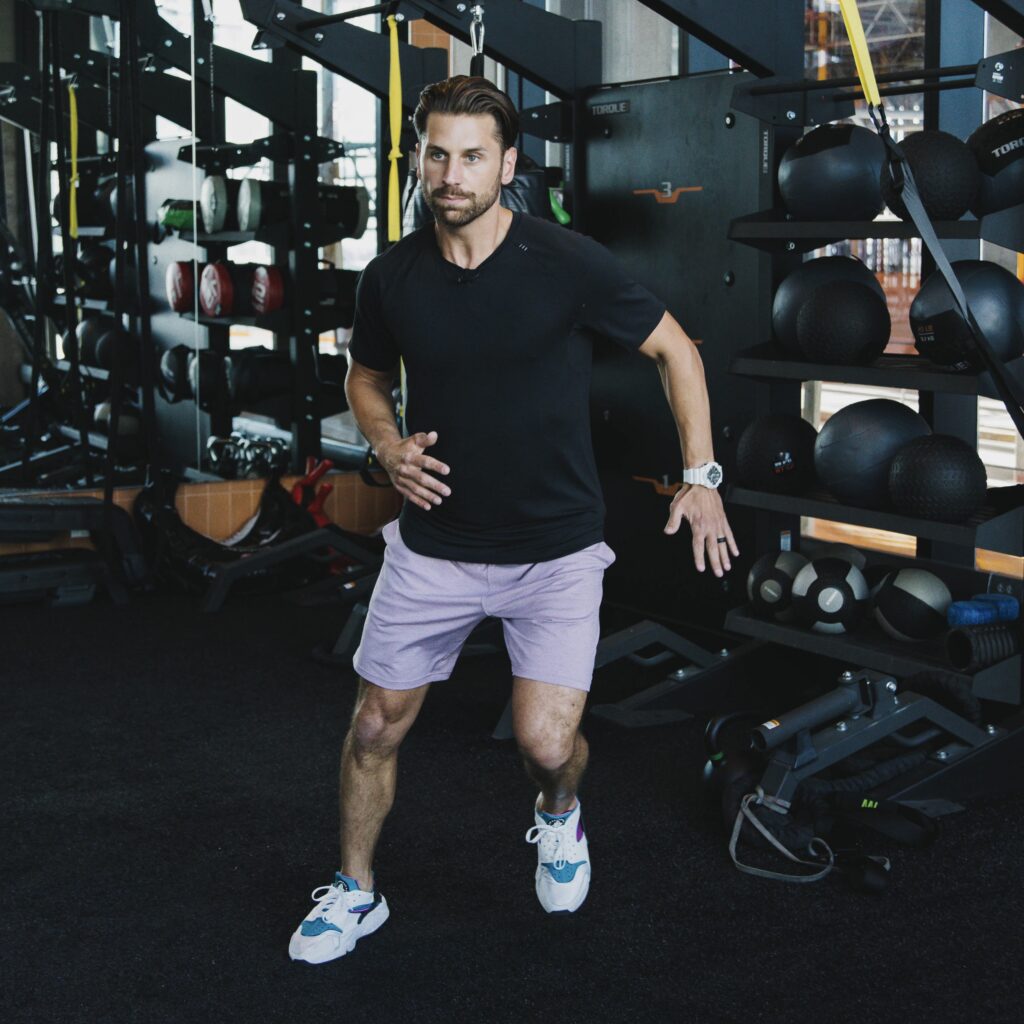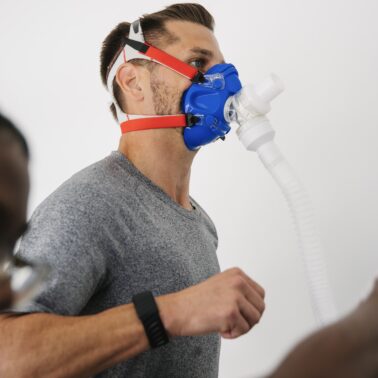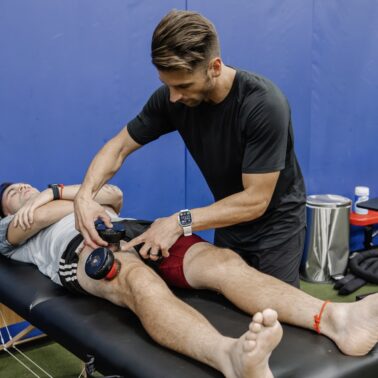“Navigating the athlete, their desires, good medicine, and external pressures is a delicate balance of return to play that requires systematic, integrative thinking.”
Adam Loiacono
What You Will Learn
- Risks associated with returning to sport too quickly, including the heightened possibility of re-injury and the development of compensatory injuries.
- Importance of psychological readiness for returning to play, noting that mental unpreparedness can lead to higher injury risk.
- Why athletes may rush their return, including their competitive nature, pressure to perform, and career concerns.
Returning to sports too soon after an injury is a significant concern for athletes at all levels. This issue is not just about the immediate risk of re-injury, but also about the long-term implications that early return to play can have on an athlete’s health and career. In this blog post, we’ll dive into the various aspects of this critical topic, discussing the risks, the psychology behind athletes’ eagerness to return, the role of medical professionals, and strategies to ensure a safe return to sports.
Understanding the Risks
Physical Risks
The most apparent danger of returning to sports too soon after an injury is the risk of re-injury. When an athlete suffers an injury, the injury itself needs time to heal fully. We cannot cheat biology – despite many biohackers or what other wishful thinkers may say. Rushing back into sports can lead to the same injury again often more severely than the first time.
Moreover, compensatory injuries can occur. These happen when an athlete, consciously or subconsciously, shifts their weight or changes their playing style to avoid pain or discomfort in the injured area. This shift can lead to strain and injury in other body parts, which were otherwise once healthy. A classic example of this is an athlete who had ACL-reconstruction surgery and is returning to running-based activities too soon when they do not have adequate quadriceps strength. They will demonstrate poor deceleration abilities, altered running mechanics, and off-load the surgical side. All of these compensatory strategies will lead to either same side or opposite side injuries.
“Biomechanical asymmetries persist after ACL reconstruction: results of a 2-year study.”
The study found that the ACLR group exhibited lower vertical and anterior-posterior ground reaction forces on the surgical limb at 6, 12, and 18 months compared to healthy limbs. They also had higher peak hip and lower knee and ankle flexion moments, suggesting a hip dominant strategy. The body will find a way to complete a task if we push ourselves to do it. The question becomes if we will demonstrate proficient mechanics to do so. This research showed the task could be completed, but with low proficiency and high compensatory movements.
Psychological Risks
Psychological readiness is as important as physical readiness. Athletes who return to play before they are mentally ready may experience lack of confidence and hesitation, which can not only impair their performance but also increase the risk of injury.
Lack of Confidence: Confidence is a cornerstone of peak athletic performance. An injury can shake an athlete’s belief in their physical capabilities. Doubting their strength, stability, or agility can make them timid in their movements, potentially reducing their effectiveness and exposing them to further injury.
Hesitation: Hesitation is a byproduct of anxiety and lack of confidence. It can cause athletes to second-guess their instincts, leading to delayed reactions or half-hearted efforts. Such hesitation not only diminishes performance but also disrupts the natural flow of movement, which can be a precursor to injury.
Overcautiousness: In an attempt to avoid another injury, athletes may become overcautious, altering their natural movements. While caution can be beneficial, excessive wariness can lead to abnormal movement patterns, compensatory strategies, and ultimately, a higher chance of injury.
Emotional Fatigue: The mental strain of recovering from an injury can be exhausting. Athletes often feel pressured to return quickly, causing stress that can lead to emotional fatigue. This fatigue impairs cognitive functions critical for competition, such as concentration, decision-making, and emotional regulation.
The Psychology Behind Early Return
Why do athletes rush back? Several factors contribute to this eagerness:
Competitive Nature
Athletes are often driven by a deep-rooted competitive spirit. This intrinsic motivation pushes them to constantly improve, outperform, and achieve excellence in their sport. The competitive nature is not just about winning games or beating opponents; it extends to personal challenges, including overcoming injuries. This drive can lead athletes to ignore or downplay pain and discomfort, perceiving it as a hurdle to be conquered rather than a signal to slow down.
They often equate playing through pain with strength and dedication, overlooking the potential long-term consequences. This mindset is particularly prevalent in high-stakes environments where the difference between first and second place can be minimal, yet the repercussions are significant. The challenge lies in balancing this competitive fire with a sensible approach to health and well-being, ensuring that the desire to compete does not lead to decisions that could jeopardize an athlete’s career or long-term health.
Pressure to Perform
The pressure to perform at a high level consistently can come from various sources, including coaches, teammates, fans, and even the athletes themselves. Coaches may inadvertently push athletes to return early, especially in critical parts of the season, driven by the need to achieve team goals. Teammates might also exert pressure, albeit indirectly, by their performance, creating a sense of urgency to return and contribute. Fans’ expectations and the media spotlight can amplify this pressure, especially for high-profile athletes.
However, the most significant pressure often comes from within. Athletes’ self-expectations, driven by personal goals and the fear of being overshadowed or replaced, can cloud their judgment. They may prioritize immediate performance over long-term health, fearing that taking the necessary time to recover fully could result in lost opportunities or diminished status in their sport. Balancing these pressures with a realistic and health-focused approach to injury recovery is crucial.
Career Concerns
For professional athletes, their sport is not just a passion but also their livelihood. Concerns about job security and career longevity are paramount. Spending extended time off the field due to injury can stir fears about losing their place on the team, being replaced, or appearing less valuable to current and prospective teams. This concern is particularly acute for athletes in highly competitive environments, where numerous others are ready to step into their role at a moment’s notice. Contract negotiations add another layer of complexity.
Athletes in contract years may feel compelled to demonstrate their worth, even at the cost of their health. The uncertainty about future opportunities can lead to hasty decisions about returning to play. For many athletes, especially those not yet established or nearing the end of their careers, the pressure to perform and secure their professional future can override the caution needed during injury recovery. Addressing these career concerns through supportive team policies, open communication, and comprehensive injury management and prevention strategies is essential in helping athletes make more balanced decisions.
Safe Return to Sport: Criteria vs. Biology Model
In the context of sports injuries and recovery, the process of determining when an athlete is ready to return to play is guided by two primary approaches: criteria-based timelines and biology-based timelines. Both approaches have their merits and limitations, and understanding the differences between them is crucial for effective injury management.
Criteria-Based Timelines
Criteria-based timelines for return to sport are structured around specific, measurable milestones that an athlete must achieve before progressing to subsequent stages of recovery. These criteria are often functional in nature, focusing on the athlete’s ability to perform certain movements or activities without pain or limitation. Common criteria include strength measurements, range of motion, stability tests, and the ability to complete sport-specific drills.
Advantages: This approach is objective and quantifiable, providing clear benchmarks for progress. It allows for personalized progression, as athletes move through the recovery stages based on their unique responses to rehabilitation.
Limitations: The main limitation is that it may not fully account for the underlying biological healing process. Achieving functional criteria doesn’t always correlate with complete tissue healing, which can vary significantly among individuals.
Biology-Based Timelines
Biology-based timelines, on the other hand, are grounded in the physiological healing rates of different tissues. This approach considers the biological processes involved in tissue repair and regeneration, establishing a timeline based on the expected healing duration of the injured tissue.
- Bone: Bone injuries, such as fractures, typically follow a more predictable healing timeline. Most fractures heal within 6-8 weeks, although this can vary based on the location and severity of the fracture, and the age and health of the individual.
- Anterior Cruciate Ligament (ACL): ACL reconstructions have one of the longer recovery timelines, often requiring 6-9 months before return to sport. This is due to the time needed for the graft to fully integrate and stabilize within the knee joint.
- Meniscus: Meniscal injuries vary in healing time depending on whether they are treated conservatively or surgically. Surgical repair can require 3-6 months for full recovery, while conservative management might allow for an earlier return.
- Ligament Sprains: The healing time for ligament sprains, such as ankle sprains, depends on the severity (Grade I, II, or III). Mild sprains (Grade I) may heal in a few weeks, while severe sprains (Grade III) can take several months.
- Muscle Strains: Muscle strains also vary based on severity. Minor strains may heal within a few weeks, but more severe strains can take several months to fully recover.
Advantages: This approach is grounded in the biological reality of the body’s healing process, providing a more realistic timeline for tissue recovery.
Limitations: Biological healing rates are averages and can vary widely among individuals. This approach may not adequately account for individual differences in healing capacity and the influence of rehabilitation interventions.
In practice, the most effective return-to-sport strategy often involves a combination of both criteria-based and biology-based approaches. While criteria-based milestones ensure that the athlete regains functional ability and strength, considering biological healing timelines ensures that the tissue has adequately recovered to withstand the demands of sport. This integrated approach helps balance the need for objective measures of readiness with an understanding of the inherent variability in the body’s healing processes.
Sample Return to Play Protocol
I. Rest and Recovery: The Foundation of Healing
Immediate Action: Right after an injury, it’s crucial to stop all activities that could aggravate the condition. This is often summarized as the RICE method – Rest, Ice, Compression, and Elevation.
Monitoring and Assessment: During this phase, regular monitoring and assessments by medical professionals are essential to track healing progress.
Mental Health Considerations: Rest is not only physical. Psychological rest, including stress management and coping strategies, is also important, as mental stress can impede physical healing.
Nutrition and Hydration: Proper nutrition and hydration play a significant role in recovery. A diet rich in proteins and anti-inflammatory foods can aid in recovery.
II. Rehabilitation: Building Strength and Movement
- Physical Therapy: The introduction of physical therapy is aimed at restoring local strength and mobility. This starts with simple, non-painful movement that progresses to more compound movements as tolerance increases.
- Pain Management: either using medication or modalities, pain needs to be reduced to make progress. Pain is our body’s danger signal and should not be ignored.
- Personalized Programs: Beyond the injury itself, consideration to the entire body and person will help personalize the needs for the plan.
- Progress Tracking: Regular assessments to track progress and adjust the rehabilitation program as needed are essential.
III. Controlled Training: Gradual Sport-Specific Reintegration
Non-Contact Drills: Initial training should avoid any risk of contact or re-injury. For example, a basketball player might start with shooting drills before moving on to defensive maneuvers.
Low-Intensity Training: Activities should start at a low intensity and gradually increase. The focus should be on technique and controlled execution rather than speed or power.
Sport-Specific Exercises: Exercises should mimic the demands of the sport to prepare the athlete for the types of movements and scenarios they will face.
Feedback and Adjustment: Constant feedback from coaches and trainers is crucial to adjust the training intensity and content appropriately.
IV. Return to Practice: Rejoining the Team Environment
- Participation without Restrictions: At this stage, the athlete should be capable of participating in team practices without restrictions, but still under close observation.
- Gradual Exposure: Initially, athletes might participate in a portion of the practice, gradually increasing their involvement.
- Contact Integration: If the sport involves contact, this should be reintroduced slowly and monitored for any adverse reactions or hesitations.
- Team Dynamics: Reintegration into team dynamics is also crucial, allowing the athlete to readjust to team strategies and coordination.
V. Return to Play: Full Competitive Participation
- Competitive Readiness: Athletes should only return to full competitive play when they have regained pre-injury form in terms of strength, flexibility, endurance, and skill.
- Mental Preparedness: Confidence and readiness to compete at full intensity without fear or hesitation are vital.
- Medical Clearance: Obtaining a final medical clearance ensures that all parties – the athlete, medical staff, and coaching staff – are confident in the athlete’s ability to return safely.
- Ongoing Monitoring: Even after returning to play, athletes should be closely monitored for any signs of issues related to the previous injury.
Each of these stages is crucial and should not be rushed. Skipping stages or rushing through them increases the risk of re-injury. The athlete’s health and well-being should always be the priority in any return-to-play protocol.
Conclusion
Returning to sports after an injury is a delicate balance that requires careful consideration of both physical and psychological readiness. Athletes, coaches, and medical professionals must work together to ensure that this return is safe and sustainable. By understanding the risks, addressing the psychological aspects, and following a structured return to play protocol, athletes can minimize the chances of re-injury and have a successful comeback to the sport they love.
By prioritizing health and long-term well-being over immediate return to play, athletes can enjoy a longer and more fulfilling sporting career. It’s essential to remember that while the desire to return to play is understandable, the risks of returning too soon are real and can have lasting consequences. Patience, careful planning, and a focus on complete recovery are key to ensuring a safe and effective return to sports.



